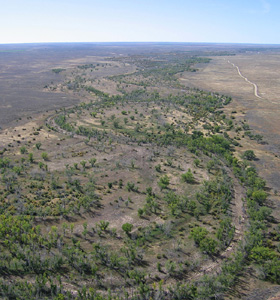
|
Landscapes of the
Central Great Plains
Chapter VIII
Osage Cuestas and
Chautauqua Hills
James S. Aber and Susan W. Aber
Emporia State University Emeritus
|
VIII.1 Introduction
The Osage Cuestas covers much of eastern Kansas south of the glaciated region and east of the Flint Hills. Among the smaller and more distinctive landscape regions, the Chautauqua Hills forms a narrow band within the Osage Cuestas in southeastern Kansas (see landscape maps).

| Woodson County State Fishing Lake and Wildlife Area in the Chautauqua Hills. Note the dense oak forest on the sandstone bluff east of the lake. Autumn foliage is evident in this early November view. Helium-blimp airphoto.
|
Both regions are underlain by Pennsylvanian shale, limestone and sandstone to varying degrees (see geologic maps). Shale and limestone dominate the Osage Cuestas, and sandstone is most prominent in the Chautauqua Hills. Elevations range overall from >1300 feet (400 m) in southeastern Lyon County to a low at 679 feet (205 m) where the Verdigris River flows into Oklahoma (the lowest point in Kansas).
 Return to beginning.
Return to beginning.
VIII.2 Osage Cuestas geology
Most of the Osage Cuestas consists of rolling hills and undulating cuestas of relatively low relief underlain by shale, limestone, and poorly consolidated sandstone. The term cuesta refers to slightly tilted rock layers with the surface expression of a gentle slope that is truncated by a steep cliff or escarpment. In eastern Kansas, Johnston (1964) described cuestas simply as a regional trend that occurred when the alternating limestone and shale layers were tilted slightly downward to the west as a result of uplift of the Ozark Dome in southern Missouri. Erosion removed shale more quickly than limestone and this created gentle slopes of resistent limestone layers that face westward and steep slopes of weathered shale that face roughly eastward.
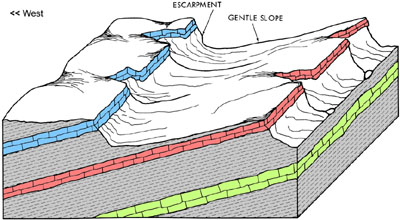
| Schematic diagram of cuesta landforms typical in eastern Kansas created by differential erosion of gently dipping limestone and shale layers. The landscape resembles giant stairsteps slightly tilted down toward the west. Adapted from Wilson (1978).
| |
Trending from north-northeast to south-southwest are several narrow escarpments formed on thick, resistant limestone layers. These are present both in the Osage Cuestas and Glacial Hills. Good examples include Hancock Hill at Fort Leavenworth, Mount Oread in Lawrence, Burnett Mound in Topeka, Sugar Mound at Mound City, and Table Mound at Elk City Lake. Along such prominent escarpments, local relief may exceed 300 feet (90 m) and landslips may happen on steep shale slopes below the limestone cap. Between major escarpments, however, cuestas may display quite low relief.

| Butcher Falls, near Sedan in Chautauqua County. A massive layer of Plattsmouth Limestone supports the waterfall. The Plattsmouth Limestone Member is part of the Oread Limestone, which forms a prominent escarpment across eastern Kansas from Leavenworth to Lawrence and southward to Sedan. |

| Superwide-angle autumn overview of mixed land use in the Osage Cuestas near Americus in Lyon County. The region is underlain by shale interbedded with thin limestone layers. Pastures, crop fields, wooded tracts, and small ponds are typical of upland areas. Kite aerial photograph by ESU students.
|
The region is underlain by Upper and Middle Pennsylvanian bedrock in which layers are arranged in repeated cycles. These cyclothems of eastern Kansas were made famous by state geologist R.C. Moore, who described and interpreted these strata and their invertebrate fossils in the mid-twentieth century (Moore 1964). The dominant rocks of Pennsylvanian cyclothems are shale, limestone, and sandstone. Distinctive elements include coal beds and black shale. In contrast with Permian cyclothems of the Flint Hills, chert is relatively scarce within the limestone units, red shale is rarely present, and sandstone is common, particularly toward the south. These repeated cycles of deposition represent advances and retreats of shallow seas across the region during the Pennsylvanian, when North America was situated near the Equator in a tropical climatic zone.
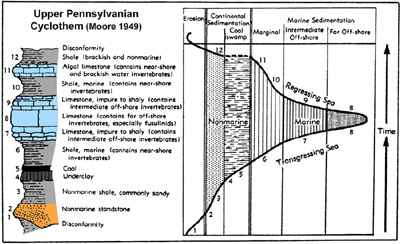
| Classic model for an Upper Pennsylvanian cyclothem. Numbers (1-12) indicate stages of marine transgression and regression and the resulting sedimentary deposits. Adapted from Moore (1949); used with permission, Geological Society of America.
| |
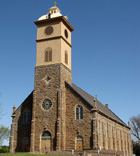
| St. Francis de Hieronymo Catholic Church in the Osage Cuestas of Neosho County. The building was constructed in 1871-1884 of native sandstone, presumably the Bandera Quarry Sandstone Member of the Marmaton Group. Overview (left) and detail of the nave wall (right). Sandstone represents the regressive phase (2) of a cyclothem. Scale pole marked in feet.
| 
|
Many ideas for Pennsylvanian and Permian cyclothems of the midcontinent have been offered over the years. These explanations generally fall into three categories—regional crustal movements, local delta-lobe shifting, and global sea-level changes. Frequent fluctuations in sea level reaching 80-100 m in height were, in fact, worldwide events driven by ice-sheet glaciation (Soreghan and Giles 1999). The center of glaciation was Gondwana, a megacontinent located on or near the South Pole (Caputo and Crowell 1985). Most geologists now recognize that Pennsylvanian and Permian cyclothems in Kansas were connected with this late Paleozoic ice age (Boardman and Barrick 1989).
 Return to beginning.
Return to beginning.
VIII.3 Osage Cuestas drainage
Several major tributaries of the Missouri and Arkansas drainage basins cross the Osage Cuestas. In zones underlain by shale and sandstone, streams have eroded wide valleys with gentle sides and low terraces. However, where rivers cross escarpments in resistant limestone the valleys are narrow with steep bluffs, as at Elk City Lake in Montgomery County.

Early spring view over the broad valley of the Neosho River at St. Paul, Kansas. This vicinity is underlain mainly by easily erodible Holdenville Shale and Nowata Shale of the Marmaton Group. Kite aerial photograph.
| |
As streams cut downward into their modern valleys, they also migrated sideways. Most rivers flow generally from west to east or northwest to southeast, and through time they have shifted systematically southward during valley entrenchment. Thus, terraces and old channel gravels are found mostly along northern sides of valleys. The gravels are composed mainly of chert, derived from the Flint Hills, and are similar to the Leon Gravel (Aber 1992). Most of these gravels also contain exotic quartz and quartzite pebbles derived from the High Plains and Rocky Mountains, which indicates the ancestral rivers had headwaters much farther to the west than do modern streams of the region (Aber 1997).

| Hill-top chert gravel in northwestern Emporia. Typical exposure (left). Gravel rests on weathered bedrock of the Wood Siding Formation. Note iron oxidation (reddish brown) in the gravel and underlying bedrock. Selected exotic pebbles (right). Most are quartzite; pebble at lower left is granite. Taken from Aber (2018).
| 
|
Such chert gravel is resistant to erosion and is found on high terraces, hill tops, and drainage divides up to 250 feet (75 m) above modern valleys. The high topographic positions of alluvial chert gravel demonstrate the magnitude of stream downcutting and general erosion of the landscape since the oldest and highest gravels were deposited in the late Miocene and Pliocene (Merriam and Harbaugh 2004).
This is a good example of inversion of topography, in which what was the lowest feature—gravel deposits in river channels—is now in the highest landscape position—terrace gravel on drainage divides. Assuming a late Pliocene age for the highest chert-gravel terraces gives a vertical incision rate of 1.5 cm/1000 years and a lateral (southward) stream migration rate of >2 m/1000 years (Aber 2019).
Most larger cities are located within river valleys because of the proximity to surface water. However, flooding is a perennial problem owing to infrequent strong storms and high runoff rates from the mostly shaley uplands. Many large reservoirs have been constructed for flood control, recreation, and water supply, and tens of thousands of small ponds have been built throughout the region. In spite of these precautions, flooding remains a danger, as Coffeyville, Iola, and other cities experienced in 2007. In river valleys, alluvial sediment may provide ample high-quality groundwater for domestic, agricultural, and city use. In uplands, however, groundwater is scare, hard, or mineralized with iron and manganese.
Large reservoirs in eastern Kansas suffer from rapid sedimentation that has reduced surface water storage significantly. Of 24 federal reservoirs, nearly half had lost more than 15% of their original storage capacity by 2015 (deNoyelles et al. 2016). Six already had lost more than one-third of their capacity, and Tuttle Creek and Toronto had each exceeded 40% loss. The primary reasons for rapid infilling of these reservoirs are erodible and nutrient-rich soils in the agricultural croplands that make up much of the drainage basins. Dealing with this problem is a long-term challenge for which there are no easy solutions.

| Major reservoirs dammed on rivers in the Osage Cuestas. Fall River Lake in Greenwood County (left), and Pomona Lake in Osage County (right). Fall River has lost more than one-third of its original storage capactiy, and Pomoma has lost nearly one-quarter of its capacity. Kite and helium-blimp airphotos by ESU students.
| 
|
Small oil and gas fields are found throughout the region, but most of these are old and long past their most productive years. In the early 21st century, a new form of energy generation appeared in Kansas, namely wind farms, which are situated in topographically prominent locations. One such geomorphic feature is the divide between the Missouri River and Arkansas River drainage basins. This is the master drainage divide, which extends across the entire state from west to east. A series of wind farms exploit this divide, including three in the Osage Cuestas.
Wind farms on the Missouri-Arkansas drainage divide
Arranged from west (top) to east (bottom)
Wind farm | Region | County | Wind speed | Year |
| Central Plains | High Plains | Wichita | 8.5-9.0 m/s | 2009 |
| Cedar Bluff | High Plains | Ness | 9.0-9.5 m/s | 2015 |
| Diamond Vista | Smoky Hills | Marion | 8.5-9.0 m/s | 2018 |
| Reading | Osage Cuestas | Lyon, Osage | 8.0-8.5 m/s | 2020 |
| Ad Astra | Osage Cuestas | Coffey | 8.0-8.5 m/s | 2015 |
| Prairie Queen | Osage Cuestas | Allen | 7.5-8.0 m/s | 2019
|
Based on the U.S. wind turbine database (USWTD 2022).
Average wind speed at 100 m above ground.
Adapted from Aber and Aber (2020).

| Newly erected, but not yet operational Siemens Gamesa wind turbines in the Reading wind farm in the spring of 2020. Total height of this turbine is 134 m (440 feet). Located near the Missouri-Arkansas drainage divide in the Osage Cuestas, Lyon County. Kite airphoto.
|
 Return to beginning.
Return to beginning.
VIII.4 Chautauqua Hills
The Chautauqua Hills includes parts of Woodson, Greenwood, Wilson, Elk, Montgomery and Chautauqua counties. Elevations range from about 725 feet (220 m) in the Caney River valley at the Oklahoma boundary to above 1150 feet (350 m) in eastern Elk County. Local relief is typically 100-150 feet (30-45 m) and exceeds 200 feet (60 m) in some places. Steep hill sides separate valley bottoms from plateau hill tops.
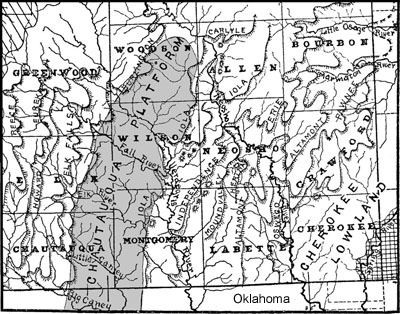
| Physiographic features of southeastern Kansas showing the "Chautauqua Platform" (gray) and several prominent escarpments in the Osage Cuestas. Cross hatching indicates the Ozark Plateau. Modified from Adams (1897-98).
| |
Thick Upper Pennsylvanian sandstones within the Douglas Group, namely the Tonganoxie and Ireland sandstone members, are the geological foundation for the Chautauqua Hills. The sand was deposited in river and delta channels that drained from the continental interior toward the late Paleozoic sea. Consequently marine fossils are scarce; plant fragments and trace fossils are common, and petrified wood is found occasionally. These sandstones are poorly consolidated for the most part, although some portions are solidified by iron oxide cement which accounts for the typical rusty brown color.

| Exposure of sandstone in the Douglas Group near Sedan in Chautauqua County. The sandstone channel is about 8 feet thick at its center and thins to 3-4 feet thick to the left and right. Scale pole marked in feet.
|
During the middle Cretaceous, about 90 million years ago, southeastern Kansas was intruded by igneous pipe structures that carried up lamproite magma from the mantle along with deep crustal rock fragments. The hot magma metamorphosed adjacent rocks and created concentric ring structures that are reflected by drainage patterns in the modern landscape. Well-studied examples include Silver City Dome in the Chautauqua Hills and nearby Rose Dome in the Osage Cuestas, both in Woodson County (Wojcik and Knapp 1990; Aber and Aber 2001). Related pipe intrusions of similar ages took place in Riley County of the Flint Hills and Marshall County of the Glacial Hills (Kempton et al. 2019), as well as central Arkansas at Crater of Diamonds State Park.
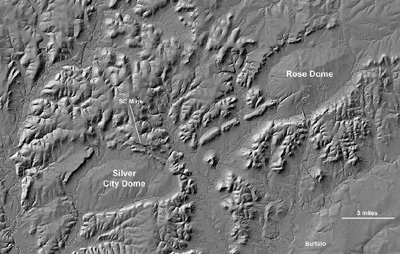
| Silver City and Rose domes, near Buffalo in southeastern Kansas. Location of the Silver City (SC) mine is indicated. Shaded-relief digital elevation model based on high-resolution lidar data. Adapted from an image prepared by A. Peterson; used with permission.
| |

| Rocks exposed at the Silver City mine. Left – gold-colored flakes of phlogopite (mica) embedded in a fine-grained, blue-green matrix of lamproite. Right – brecciated and folded skarn in the contact-metamorphic zone next to the intrusion. Dollar coin is 1.1 inches in diameter.
| 
|
Toronto Lake is a large reservoir dammed on the Verdigris River. Two smaller lakes are Yates Center Reservoir and Woodson County State Fishing Lake. Groundwater is abundant in the sandstone aquifer, but is typically hard with high iron and manganese contents, which limit its usefulness.

| Verdigris River valley (left) with Toronto Lake in the background. Spring view looking downstream toward the southeast in Greenwood County; kite aerial photograph. Woodson County State Fishing Lake and dam (right). Note mixed land cover with forest on steeper slopes and mowed pasture and crop fields on the upland. Helium-blimp airphoto.
| 
|
Numerous small oil and gas fields exist in the Chautauqua Hills region. Natural gas production helped fuel a regional ceramics industry in the late nineteenth and early twentieth centuries, but this industry closed down when the natural gas was largely exhausted. Drilling for and production of coalbed methane underwent a boom in the 1990s and early 21st century. The weathered rock at Silver City is mined in a large open pit, and the mica is processed and sold as a cattle-feed additive, known by the trade name Microlite.

| Open-pit mine and processing plant at Silver City. Year by year, the mine expands as it follows the body of lamproite bedrock near the surface. Kite aerial photograph.
|
 Return to beginning.
Return to beginning.
 Combined references.
Combined references.

 Return to Landscapes table of contents.
Return to Landscapes table of contents.
All text and images © by the authors (2022).


 Return to beginning.
Return to beginning. Return to beginning.
Return to beginning. Return to beginning.
Return to beginning.
 Return to beginning.
Return to beginning. Combined references.
Combined references.
 Return to Landscapes table of contents.
Return to Landscapes table of contents.